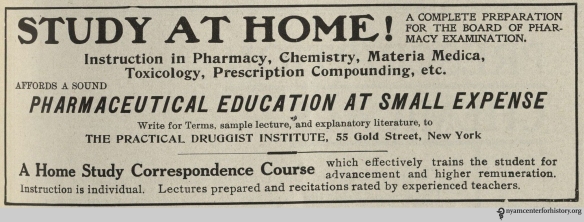By Johanna Goldberg, Information Services Librarian
This is part of an intermittent series of blogs featuring advertisements from medical journals. You can find the entire series here.

Ad published in The Practical Druggist and Review of Reviews, volume 35, number 5, May 1917. Click to enlarge.
By the late 1800s, a pharmacist (or druggist) stood at an interesting intersection in the marketplace. Both business person and medical professional, the pharmacist had to balance the responsibilities of dispensing medicine with the need to keep a business afloat.
This was in part due to changes in the field. As Gregory Higby explains in a Bulletin for the History of Chemistry article, “With most basic preparations now available from drug companies, anyone with enough courage and capital could open up a drugstore. The number of pharmacists grew enormously, and the quality of prescriptions dispensed declined accordingly.”1 Fortunately, this decline led to increased industry regulation.
The first pharmacy school in the United States, the Philadelphia College of Pharmacy, opened in 1821, a year after the formation of the U.S. Pharmacopeia.2 By the end 1870s, state laws began regulating pharmacy throughout the Unites States, including state licensing exams for pharmacists.1 Not everyone attended a pharmacy school before taking the exam; a correspondence course option existed, as advertised in The Practical Druggist in 1917.

Ad published in The Practical Druggist and Review of Reviews, volume 35, number 2, February 1917.

Ad published in The Practical Druggist and Review of Reviews, volume 22, number 2, August 1907. Click to enlarge.
Drugs, too, came under closer scrutiny. In 1848, Congress passed the Drug Importation Act, which aimed to prevent the importation of tainted drugs from abroad. In 1906, Congress passed the Food and Drug Act, setting up the regulatory charge of the Food and Drug Administration and requiring the listing of alcohol and opiates on ingredient labels.3,4 In 1912, the Sherley Amendment prevented drug labels from including false health claims.3 Cocaine was available over-the-counter until 1916; heroin and other opiates could be sold legally in the United States until 1920.5,6
The pharmacy had “developed the warmth and hospitality of a country store,” with tobacco counters, home goods for sale, and, beginning in 1835, soda fountains.7 The soda fountain business turned pharmacy shops into social centers; as they grew in popularity, store owners added seats and tables, devoting large parts of the store to the soda fountain business (a trend that lasted into the 1960s).7
Enjoy these ads showing the wide variety of merchandise available to pharmacists, presented chronologically. Click on an ad to enlarge the image.

Ad published in Omaha Druggist, volume 7, number 1, January 1894.

Ads published in Omaha Druggist, volume 7, number 4, April 1894.

The cover of The Practical Druggist and Review of Reviews, volume 3, number 1, January 1898.

Ad published in The Practical Druggist and Review of Reviews, volume 5, number 5, May 1899.

Ad published in American Druggist and Pharmaceutical Record, volume 36, number 2, January 25, 1900.

Ads published in American Druggist and Pharmaceutical Record, volume 36, number 2, January 25, 1900.

Ad published on the cover of American Druggist and Pharmaceutical Record, volume 36, number 6, March 25, 1900.

Ad published in American Druggist and Pharmaceutical Record, volume 36, number 6, March 25, 1900.

Ad published in American Druggist and Pharmaceutical Record, volume 45, November 7, 1904.

Ads published in The Practical Druggist and Review of Reviews, volume 22, number 2, August 1907.

Ad published in The Practical Druggist and Review of Reviews, volume 22, number 4, October 1907.

Ad published in The Spatula, November 1910.

Ad published in The Practical Druggist and Review of Reviews, volume 35, number 1, January 1917.

Ad published in The Practical Druggist and Review of Reviews, volume 35, number 2, February 1917.

Ad published in Omaha Druggist, volume 32, number 4, April 1919.
References
1. Higby GJ. Chemistry and the 19th-century American pharmacist. Bull Hist Chem. 2003;29(1):9–17. Available at: http://www.scs.illinois.edu/~mainzv/HIST/bulletin_open_access/v28-1/v28-1%20p9-17.pdf. Accessed August 21, 2014.
2. pharmacy. Encycl Br. 2014. Available at: http://www.britannica.com/EBchecked/topic/455192/pharmacy/35617/History-of-pharmacy. Accessed August 21, 2014.
3. Food and Drug Administration. A history of the FDA and drug regulation in the United States. 2006. Available at: http://www.fda.gov/downloads/Drugs/ResourcesForYou/Consumers/BuyingUsingMedicineSafely/UnderstandingOver-the-CounterMedicines/ucm093550.pdf. Accessed August 21, 2014.
4. Baker PM. Patent medicine: Cures & quacks. Available at: http://www.pilgrimhallmuseum.org/pdf/Patent_Medicine.pdf. Accessed August 22, 2014.
5. Miller RJ. A brief history of cocaine. Salon. 2013. Available at: http://www.salon.com/2013/12/07/a_brief_history_of_cocaine/. Accessed August 27, 2014.
6. Narconon International. History of Heroin. Available at: http://www.narconon.org/drug-information/heroin-history.html. Accessed August 27, 2014.
7. Richardson LC, Richardson CG. The pill rollers: A book on apothecary antiques and drug store collectibles. Harrisonburg, Va.: Old Fort Press, 1992.
